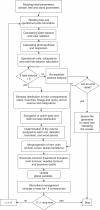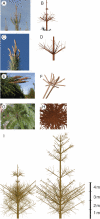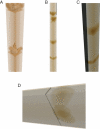A functional-structural model for radiata pine (Pinus radiata) focusing on tree architecture and wood quality
- PMID: 21987452
- PMCID: PMC3189843
- DOI: 10.1093/aob/mcr156
A functional-structural model for radiata pine (Pinus radiata) focusing on tree architecture and wood quality
Abstract
Backgrounds and aims: Functional-structural models are interesting tools to relate environmental and management conditions with forest growth. Their three-dimensional images can reveal important characteristics of wood used for industrial products. Like virtual laboratories, they can be used to evaluate relationships among species, sites and management, and to support silvicultural design and decision processes. Our aim was to develop a functional-structural model for radiata pine (Pinus radiata) given its economic importance in many countries.
Methods: The plant model uses the L-system language. The structure of the model is based on operational units, which obey particular rules, and execute photosynthesis, respiration and morphogenesis, according to their particular characteristics. Plant allometry is adhered to so that harmonic growth and plant development are achieved. Environmental signals for morphogenesis are used. Dynamic turnover guides the normal evolution of the tree. Monthly steps allow for detailed information of wood characteristics. The model is independent of traditional forest inventory relationships and is conceived as a mechanistic model. For model parameterization, three databases which generated new information relating to P. radiata were analysed and incorporated.
Key results: Simulations under different and contrasting environmental and management conditions were run and statistically tested. The model was validated against forest inventory data for the same sites and times and against true crown architectural data. The performance of the model for 6-year-old trees was encouraging. Total height, diameter and lengths of growth units were adequately estimated. Branch diameters were slightly overestimated. Wood density values were not satisfactory, but the cyclical pattern and increase of growth rings were reasonably well modelled.
Conclusions: The model was able to reproduce the development and growth of the species based on mechanistic formulations. It may be valuable in assessing stand behaviour under different environmental and management conditions, assisting in decision-making with regard to management, and as a research tool to formulate hypothesis regarding forest tree growth and development.
Figures










References
-
- Arneth A, Kelliher FM, McSeveny TM, Byers JN. Net ecosystem productivity, net primary productivity and ecosystem carbon sequestration in a Pinus radiata plantation subject to soil water deficit. Tree Physiology. 1998;18:785–793. - PubMed
-
- Bamber RK, Burley J. The wood properties of Radiata pine. London: Commonwealth Agricultural Bureaux; 1983.
-
- Bannister MH. Some variations in the growth pattern of Pinus radiata in New Zealand. New Zealand Journal of Science. 1962;5:342–370.
-
- Barrales L, Peña I, Fernández de la Reguera P. Validación de modelos: un enfoque aplicado. Agricultura técnica. 2004;64:66–73.
-
- Barthélémy D, Caraglio Y, Costes E. Architecture, gradients morphogénétiques et âge physiologique chez les végéteaux. In: Bouchon J, de Reffye Ph, Barthélémy D, editors. Modélisation et simulation de l'architecture des végéteaux. Paris: INRA Editions; 1997. pp. 89–136.

